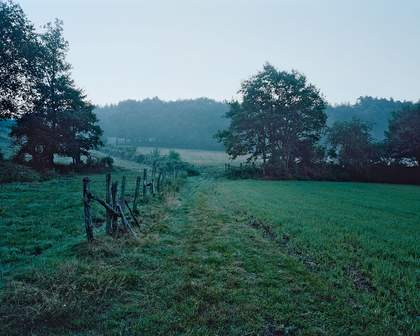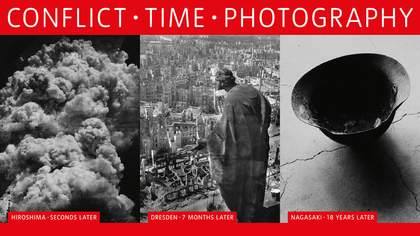
Chloe Dewe Mathews
Vanemont, Vosges, Lorraine from the series Shot at Dawn 2013
C-type print on paper, 1200mm x 1500mm
© Chloe Dewe Mathews, courtesy the artist
As I stand in the 4am darkness, at the edge of an empty field in Flanders, I know that there is an absurdity to what I’m doing. Why am I searching for an event that took place 100 years ago? Why am I scrutinizing the landscape when I know what I’m looking for is long gone?
For the past two years I’ve been driving from London to Belgium and Northern France every few months. I get up early and walk to a point in the landscape where I take a photograph as the day breaks. The resulting works form a series that records the exact places in which British, French and Belgian soldiers were executed by their own men after being convicted of ‘cowardice’ or desertion during the First World War. Military protocol determined that the death sentence should be carried out at first light, and consequently they have become known colloquially as the soldiers who were ‘shot at dawn’.
In Britain, the files on the subject were closed to the public until the 1990s. When they were finally made available, it became clear that in addition to the French, Belgian and German armies who shot their own side, around 1,000 men were executed by firing squads between 1914-18. Although this figure is minute in relation to the vast number of casualties on the frontline, the manner in which these soldiers met their end has generated a great deal of controversy since then. In some cases, shell shock or years of good service weren’t taken into account when verdicts were reached and official pardons have since been granted.
For months I researched these cases, trawling through courts martial documents, using old aerial photographs and monastery diaries to pinpoint the precise locations in which each man was executed. Academics, military experts, museum curators and local historians enabled my work and although many of them have dedicated their lives to researching the subject, none have comprehensively visited all sites of execution. Whether slag-heap, back of a primary school, churchyard, town abattoir or half-kempt hedgerow, these places have been altered by a traumatic event. By photographing them, I am reinserting the individual into that space, stamping their presence back onto the land, so that their histories are not forgotten.

